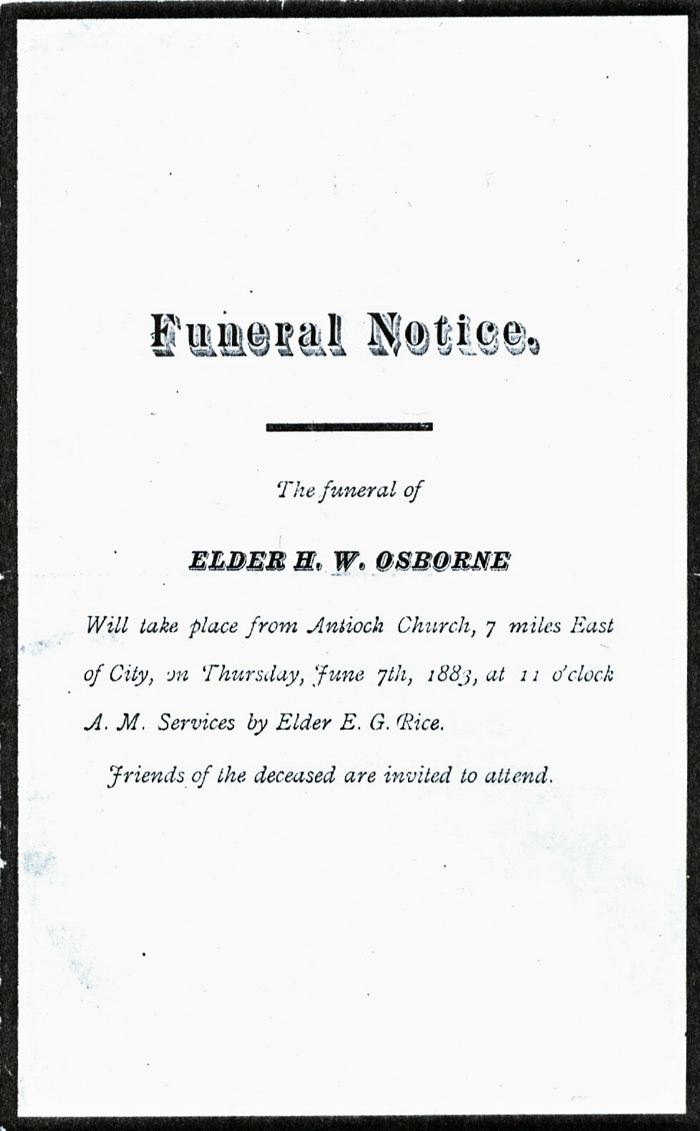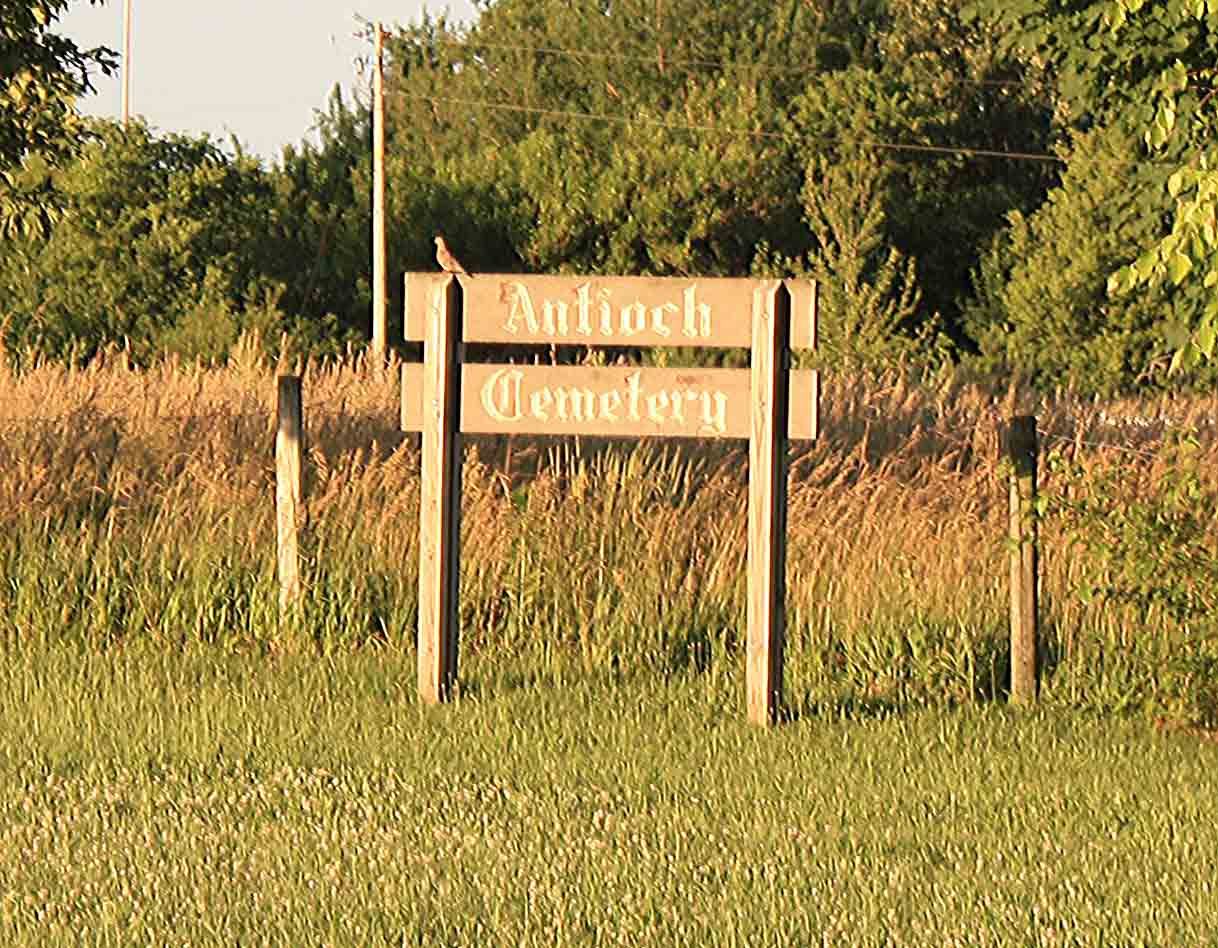Harrison William Osborne
1800-1883
Elder Harrison W. Osborne was born July 11, 1800. He was a successful evangelist on the Western Reserve. He settled and lived among Christians in Illinois. He preached among churches of Christ and was involved in the planting of churches including Jacksonville and Woodson. He traveled with B.F. Hall and Barton W. Stone preaching about the Christian churches in Kentucky, Indiana and Illinois. He settled near Jacksonville, Morgan County, Illinois to work with the church that was established by Barton W. Stone in 1836. He was married to Eliza V. Osborne (March 24, 1806-October 5, 1858). He passed from this life June 3, 1883, and is buried in the Antioch Church Cemetery, Morgan County, Illinois.
![]()
H.W. Osborne According To B.F. Hall
In this condition of affairs, I waited, and prayed, and watched the indications of Providence. About this time a Christian preacher of the name of Harrison Osborne, a young and popular minister, sent an appointment to preach in the court-house in Flemingsburg. I went to the meeting and introduced myself to him. He seemed glad to make my acquaintance, and invited me to call at his stopping place the next morning. I did so. He had heard of me, and something of my trials. He told me if I was called to preach, I ought to be at the work. He advised me to quit school and travel with him around his circuit through Fleming, Lewis, Mason and Bracken Counties. I told him I had no horse. He proposed to procure one for me, if I would go with him. I agreed to do so. He borrowed a horse for me to ride of a brother Richard Hart of Fleming County. I borrowed an outfit of my brother, and we set out. Brother Osborne's first appointment was in the country, some 8 or 10 miles from Flemingsburg.
I had been for some time in the habit of praying in public, indeed, almost from the time I joined the church. I was considered a good singer, and delighted in music, and was frequently called on to lead the singing in the congregation. I was familiar with most of the airs sung in those days, and knew most of the hymns by memory, and could learn a tune or hymn by hearing it sung a few times. After singing a few songs, brother O. requested me to open meeting with prayer. I did so. He then asked me to speak to the people. This I had never attempted to do, and asked him to excuse me at that time, promising that I would do so at the next appointment. I wanted time for reflection and to prepare something to say; but he would not let me off, telling me as I had to make a beginning. I might as well do it then as any other time. I accordingly made to effort, and a poor effort it was! In less than five minutes my resources were exhausted. I could think of nothing to say. I became embarrassed I stammered. The young people smiled and tittered. This increased my confusion, and caused me to stutter worse than ever. In this state of confusion, I sat down, deeply mortified, but not discouraged. Brother O. arose and, as I thought, delivered a fine discourse.
After dinner we started on to his next appointment. We were scarcely in our saddles when brother O. said he was anxious to hear me speak that he might decide whether I was called to preach. He said he was convinced I had mistaken my calling; that he did not believe I would ever succeed as a preacher; that my stammering would always prevent my being a public speaker of any kind; and that he did not think I could ever make myself useful as a minister; and advised me to return home and rescind the bargain I had made with my father, and ask him to take me back as a farm boy; that he thought I could succeed better as a farmer than at anything else; and much more he said to the same effect—all calculated to discourage and drive from the field almost any other young man. But it did not have this effect upon me. I related to him my first and several succeeding efforts in the ballroom, and of the final result. This made him laugh outright. He said there was quite a difference between one's heels and his head; that it did not require much sense to learn how to dance; that some of the most expert dancers he ever knew did not have sense enough to fit a dress, to cut a coat—(he had himself been a tailor) or scarcely (sense) to knit a pair of stockings; but that it required brains to make a preacher! All this I admitted might be true, but it did not follow that I would not make a preacher. I told him he might drive me away from him, if he did not wish me to go, but that He could not keep me from trying to preach. I informed him that I had not yet had a fair trial, and that it would be shameful, if nothing worse, to give up such a cause upon such an experiment; and that I never intended to abandon the work, involving consequences so momentous, without a fair trial. Seeing I was resolute and determined, and that I was not to be moved by his judgment, formed prematurely, he advised me to continue with him around the circuit. Before the month was out, he changed his opinion somewhat, revised his decision and reversed his former judgment.
![]()
Old Jackson Church
Organized 1832, by B. W. Stone; present membership, 1,200; value of property, $85,000; Bible school began 1860; present enrollment, 900.
This church was organized in October in the old courthouse that stood near the southwest corner of the square. There were seventy-two charter members. Among them were Harrison W. Osborne, Philip Coffman, John T. Jones and Josephus Hewitt-all leading spirits.
The meetings for public worship were continued in the courthouse and residences of the members until a chapel was built on Beardstown Street, which is now North Main Street. This chapel served until the early fifties, when, during the pastorate of A. J. Kane, a two-story brick building was erected on the same street. Joel Headington taught school in this house. It was in use till 1869, when, during the pastorate of Enos Campbell, a new brick house was built on East State Street. This was enlarged and remodeled in 1888, while A. N. Gilbert was pastor. The present stone structure was finished during the pastorate of R. F. Thrapp in 1906.
Throughout its life this church has always held a goodly number of representative citizens. Its ministers also have generally been men of a high type. Among the pioneers, besides those above named, there were Henry Cyrus, the first pastor; Jerry Lancaster, Jonathan Atkinson, W. W. Happy and D. P. Henderson. The church was divided during the pastorate of W. S. Russel by his unscriptural teaching. The two parties came to a mutual agreement in 1866, and under the superior ministry of Enos Campbell were welded into one. The teaching of Mr. Russel not only crippled the church for a time, but also affected adversely other congregations in the county and lost to the Disciples Berean College.
W. W. Happy, Sr. and Jr., James Stark and William Gilliam were ordained to the ministry by this congregation.
The pastorate of Mr. Thrapp "was characterized by splendid missionary expansion and progressive civic reform."
This is a great church, abounding in many good works.
Haynes, N.S. History of the Disciples In Illinois, Pages 337,338
![]()
Harrison W. Osborne
Was baptized by Barton W. Stone in 1817, and two years thereafter was ordained to the ministry. Thus he early became actively associated with Mr. Stone in his reformatory work. Mr. Osborne came to Morgan County about 1830, and was an earnest preacher in the Christian Denomination until the union of the "New Lights" and the "Reformers" into the Jacksonville Church of Christ by Mr. Stone in 1832. Thereafter, to the dose of his long and useful life, he was a faithful teacher of the truth as it is in Jesus. He was a small man physically, but with superior mental endowments and spiritual culture. He rode horseback over a wide territory and was very prompt in meeting all his engagements. His manner was modest and his voice gentle, but he emphasized those teachings of the Scriptures with great earnestness that his hearers most needed. Colonel Judy says of him: "He was quite eloquent, hewing close to the line all the way through." His last years were passed at Berlin, Sangamon County. There his beautiful and winsome character so took hold of the community that many of the young people thought they could not be married without "Uncle Harrison," and his services were in wide demand for funerals. When the burden of years became heavy upon him, he said: "I am waiting for my Saviour's welcome on the other shore."
—Haynes, N.S. History of the Disciples In Illinois, Pages 581,582
![]()
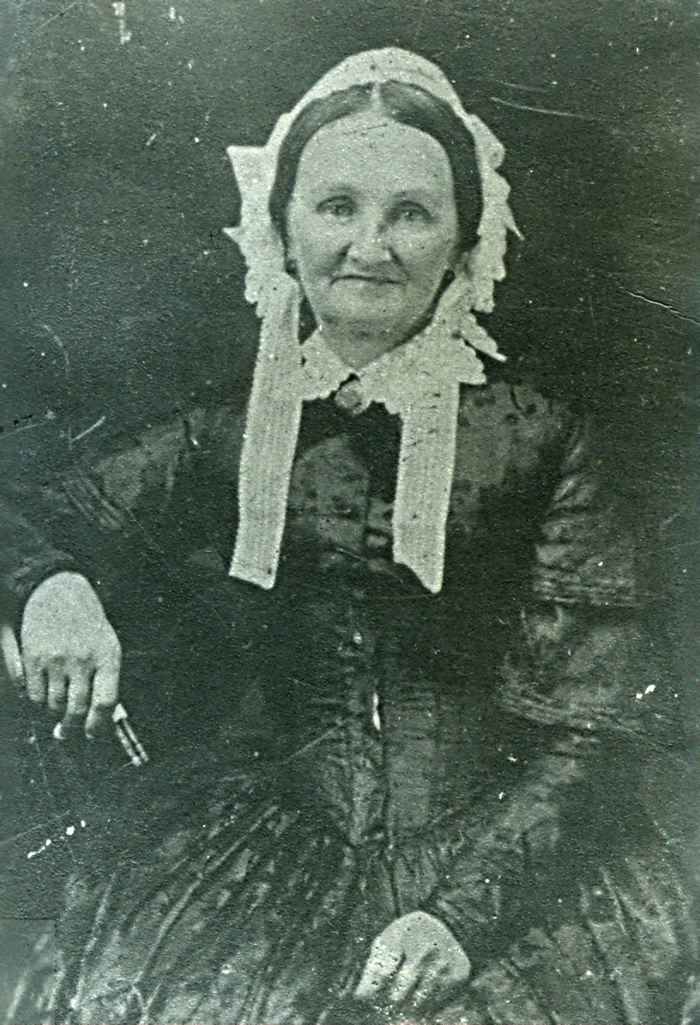
Mrs. Eliza Voorhees Cassell Osborne
wife of H.W. Osborne
![]()
Funeral Notice,
The funeral of
Elder H.W. Osborne
Will take place from Antioch Church, 7 Miles East
Of City, on Thursday, June 7th, 1883, at 11 o'clock
A. M. Services by Elder E.G. Rice.
Friends of the deceased are invited to attend.
![]()
Directions to The Grave Of Harrison Osborne
GPS Location
39.751252, -90.102767
Acc. 17' Grave Faces E
The Antioch Cemetery is located seven miles east of Jacksonville, Illinois on the north side of the Old State Road. Legal description of the cemetery site places it in the southeast quarter of Section 9, Township 15N, Range 9W. Antioch Christian Church was formerly adjacent to the cemetery. That building was moved to Ashland around 1955 and was still used for church purposes as late as April 1978. Antioch Cemetery was not incorporated until July 14, 1873. Shortly thereafter bodies were removed from nearby family cemeteries and re-interred in Antioch Cemetery. It is believed that an unusually large number of Negroes are buried in this cemetery, being family members of workers hired by the Strawn family. For a time this cemetery was the second burial site of the famous preacher, Elder Barton W. Stone. His body has since been disinterred and removed to Cane Ridge, Kentucky.
![]()
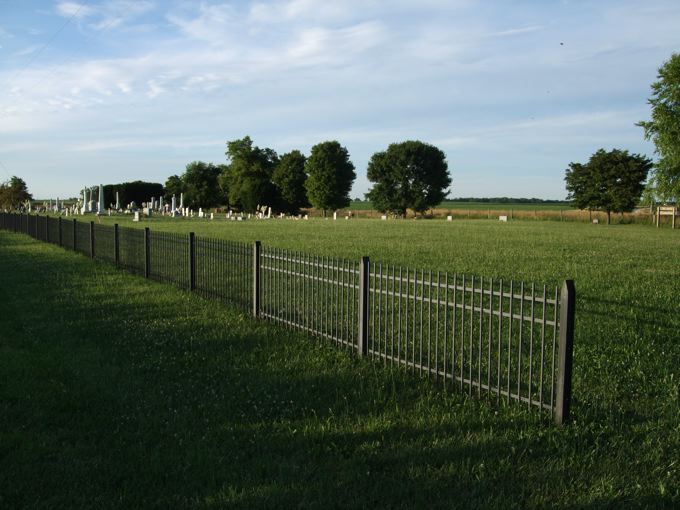
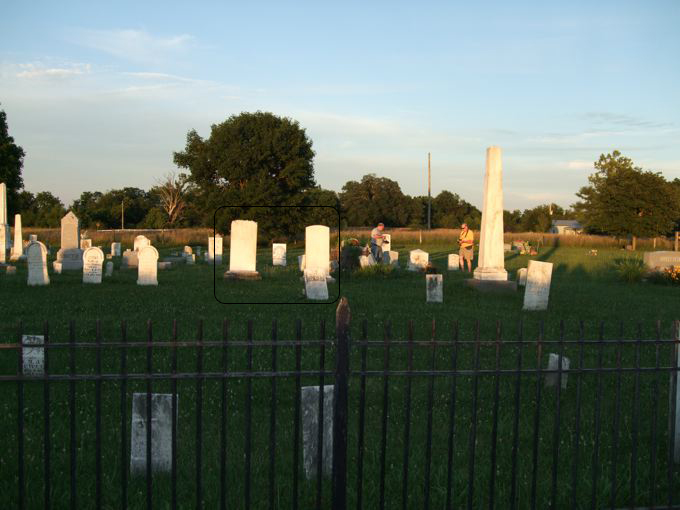
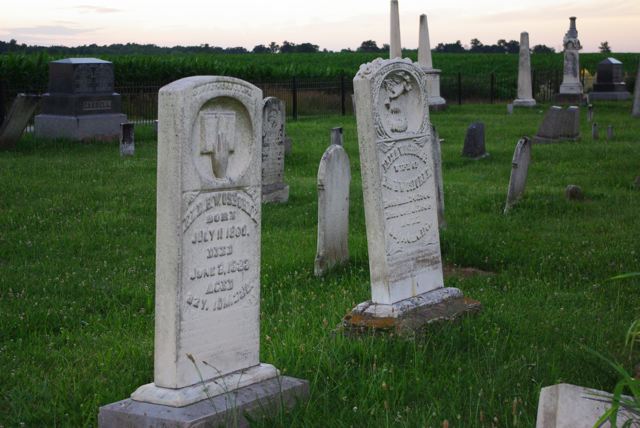
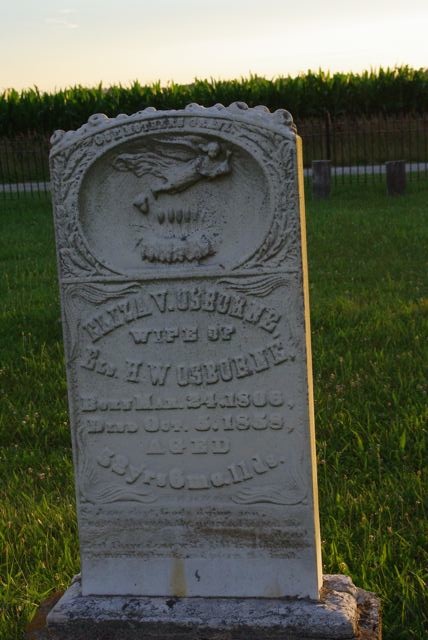
Eliza V. Osborne
Wife Of
Eld. H.W. Osborne
Born Mar. 24, 1806
Died Oct. 5, 1858
Aged
52Y. 6M. 11D.
So Jesus slept, God's Dying Son,
Passed through the grave, & blessed the dead,
Rest there dear wife till from his throne
The morning breaks and pierce the tomb.
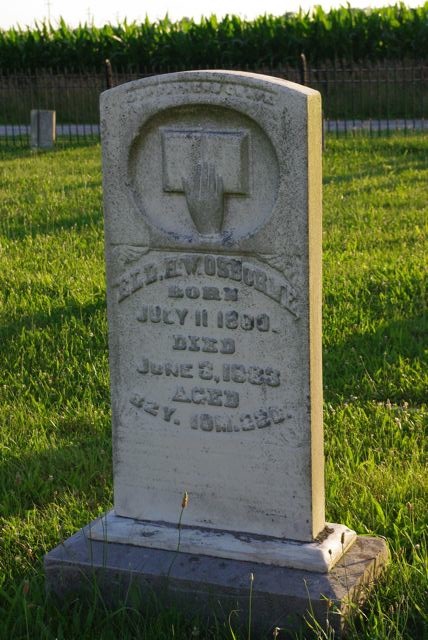
Elder H.W. Osborne
Born
July 11, 1800
Died
June 3, 1883
Aged
82Y. 10M. 22D.
Special Thanks To Ken Christensen of Bloomington, Illinois for helping to locate information on H.W. Osborne, and the Antioch Cemetery. The pictures were provided as a result of a number of circumstances. In June, 2009, the cemetery was visited by your web editor, C. Wayne Kilpatrick, and Tom Childers. It was late in the evening, and the pictures on this site were taken as the sun was going down. The photos of H.W. and Eliza V. Osborne along with the funeral notice of H.W. Osborne were provided courtesy of Phyllis (Hodgen) Hansen, a fellow historian and descendant of the Osbornes.
![]()

